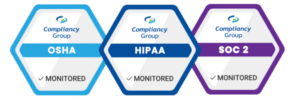
Every industry has its own set of hazards, and ensuring the safety and well-being of workers is of utmost importance. The Occupational Safety and Health Administration (OSHA) plays a crucial role in establishing guidelines to protect workers from exposure to harmful substances.
One such guideline is the Permissible Exposure Limit (PEL), which sets limits on the amount and duration of exposure to various hazardous substances. In this article, we will explore what OSHA PEL is, why it is important, and specifically look at its application for respirable crystalline silica, dust, and beryllium.
What is the OSHA Permissible Exposure Limit?
The Permissible Exposure Limit (PEL) OSHA refers to the maximum allowable concentration or level of a substance that workers can be exposed to over a specific time period without experiencing adverse health effects. These limits are established by OSHA based on extensive research, scientific studies, and recommendations from organizations like the National Institute for Occupational Safety and Health (NIOSH).
OSHA’s PELs play a crucial role in safeguarding workers’ well-being. These limits are based on extensive research and scientific evidence regarding the harmful effects of specific substances on human health. By implementing PELs, employers must identify potential risks associated with hazardous substances and take necessary measures to reduce exposure levels.
OSHA PEL for Respirable Dust
Respirable dust refers to solid particles that can be inhaled and penetrate deep into the lungs. These particles can come from various sources such as:
- construction materials
- mining activities
- manufacturing processes
To prevent respiratory illnesses caused by exposure to hazardous dust, OSHA has set specific PELs for different types of particulate matter.
For example, the current OSHA PEL for silica dust is 2 milligrams per cubic meter averaged over an 8-hour workday. This limit aims to mitigate the risk of black lung disease among coal miners. It is crucial for employers in these industries to monitor dust levels regularly and implement effective control measures to maintain worker safety.
OSHA PEL: Beryllium Exposure Control
Beryllium is a metal commonly used in various industries including aerospace, electronics, and nuclear energy. Inhalation or skin contact with beryllium particles can cause chronic beryllium disease and lung cancer.
To address these hazards, OSHA has established a lower PEL of 0.2 micrograms per cubic meter as an action level for beryllium exposure in general industry. Employers must conduct air sampling tests regularly and provide appropriate respiratory protection when necessary.
The Importance of OSHA PEL: Safeguarding Workers
The primary objective of implementing PELs is to safeguard the health and safety of workers by preventing unnecessary exposure to hazardous substances. By setting specific limits on exposure levels, employers are required to take necessary precautions such as:
- Providing Personal Protective Equipment (PPE)
- Conducting Regular Air Monitoring
- Implementing Engineering Controls
- Developing Effective Training Programs
The OSHA PEL is an essential tool for employers in evaluating workplace hazards and implementing adequate control measures. It outlines the acceptable levels of exposure for various hazardous substances, such as:
- Chemicals
- Dust Particles
- Fumes
By knowing these permissible limits, employers can take necessary actions to minimize worker exposure and create a safer work environment.
For example, one prominent substance with an established OSHA PEL is respirable crystalline silica. Respirable crystalline silica is commonly found in construction materials like:
- Sand
- Stone
- Concrete
- Mortar
The inhalation of fine silica dust can lead to serious health conditions, including silicosis, lung cancer, and chronic obstructive pulmonary disease (COPD). To protect workers from these risks, OSHA has set a PEL for respirable crystalline silica at 50 micrograms per cubic meter of air over an eight-hour work shift.
Complying with OSHA Silica PEL: Implementing Controls
Among the many hazardous substances regulated by OSHA PELs, silica dust poses significant respiratory risks. The OSHA silica PEL of 50 micrograms per cubic meter is designed to protect workers from developing diseases like silicosis and lung cancer caused by prolonged exposure to respirable crystalline silica.
To comply with this standard, employers are required to implement engineering controls such as:
- Ventilation Systems
- Wet Methods for Dust Suppression
- Use of Appropriate Personal Protective Equipment (PPE) (respirators)
Regular monitoring of airborne silica levels and medical surveillance programs also play a crucial role in ensuring compliance with the OSHA silica PEL.
Appropriate Personal Protective Equipment (PPE): Line of Defense
When it comes to minimizing worker exposure to hazardous substances, providing appropriate personal protective equipment (PPE) is crucial. PPE serves as a last line of defense when engineering controls or other control measures do not adequately eliminate the risk of exposure. This can include items such as:
- Respirators
- Gloves
- Goggles
- Protective Clothing
For instance, in a workplace where workers are exposed to beryllium – a toxic metal commonly found in industries like aerospace and electronics manufacturing – employers must ensure that workers wear appropriate respiratory protection to prevent inhalation of beryllium dust or fumes. The OSHA PEL for beryllium is set at 0.2 micrograms per cubic meter of air over an eight-hour work shift.
By providing the necessary PPE, employers can significantly reduce the likelihood of occupational illnesses or injuries caused by exposure to hazardous substances.
Ultimately, the OSHA’s Permissible Exposure Limits ensure that workers are protected from harmful substances in the workplace. By establishing limits for various hazardous materials and enforcing compliance, OSHA PELs are crucial in maintaining worker safety and preventing occupational illnesses. It is essential for employers to understand and adhere to these limits, implement appropriate control measures, and regularly monitor exposure levels to ensure a safe working environment for all employees.








